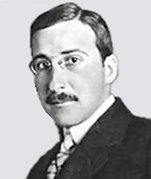|
被禁止的性行為與性暴力
|
|
賣淫: 有關的歷史記載
3
|
|
 |
|
斯蒂芬·茨威格
(Stefan
Zweig,1881-1942)
卓越作家,當納粹德國兼併他的祖國奧地利時,他流亡於國外。他的很暢銷的著作,像其他猶太作家的作品一樣曾經被查禁。他設法完成了回憶錄並遷居巴西,卻終因絕望而自殺。他的回憶錄於其逝世後得以出版。 |
|
Stefan Zweig
(1881-1942), a brilliant writer, had to flee into exile when Nazi Germany annexed his native Austria. His very popular books, like those of all other Jewish authors, were banned. He managed to complete his memoirs and move to Brazil, but eventually was overcome with despair and committed suicide. The work was published posthumously. |
|
|
許多現在哀歎存在著賣淫的人們並不知道——或者已經遺忘了,在“美好的往昔”,賣淫更為廣泛地存在著。甚至直到20世紀早期為止,不但上海一些聲名狼藉的街區及其它的亞洲城市,而且在歐洲與美國的大城市也有比現在多得多的大量的妓女存在。正如斯蒂芬·茨威格(Stefan
Zweig)就他在帝制的維也納成長的回憶錄裏曾經寫到的那樣: |
“當今一代人對大戰之前在歐洲波及範圍之廣的賣淫業幾乎沒有任何的概念了……。在那個年代,城市裏的人行道站滿了如此多忙於待價而沽的女人,以至於要避開她們比要找到她們還要難上加難。另外,那時,有著數也數不清的“緊閉門戶的房屋”、夜總會、有著歌舞表演的酒店與充斥著舞女的舞廳以及酒吧間。女性作為商品曾經時時刻刻在任何地方以任何價格公開待價而沽,並且男人購買一個女人半小時、一小時或一整夜比買一盒香煙或一張報紙還要來得方便。[斯蒂芬·茨威格.昨日的世界(Die
Welt von Gestern),1944]。
|
|
正如茨威格本人已經記載的那樣,第一次世界大戰之後,當女人(替代第一次世界大戰中已經戰死的男人)逐漸進入正規勞動大軍和當嶄新的性自由觀念讓年輕人有更多的機會相識和公開交往之時,賣淫的境況才開始發生改變。繼而,這又讓年輕男人更容易放棄去找妓女的念頭。當然,緊隨第一次世界大戰之後的數年裏,全面的經濟蕭條起先曾經導致賣淫的增加,不過,隨著婦女開始獲得解放,一種趨勢就已經在醞釀之中,那就是逐漸減少了婦女的依附性,而且這種趨勢也持續至今。不過,重新出現的經濟低迷則屬例外。例如,美國1930年代的大蕭條時期,或第二次世界大戰後西歐的貧困時期,或者現在正加入富裕的西方陣營的不發達的東歐國家。無論如何,歐洲和美國除了這些挫折時期或其中不發達地區以外,賣淫在那裏再也從未達到從前的那種規模
|
|
Prohibited Sexual Behavior and Sexual Violence |
|
Prostitution: Historical Note 3 |
|
Many people who now bemoan the existence of prostitution do not know – or have forgotten – that it was much more extensive in the “good old days”. Indeed, until early in the 20th century, not only certain infamous sections of Shanghai and other Asian cities, but also the large cities in Europe and the USA had a great many more prostitutes than they have today. As
Stefan Zweig wrote in his memoirs about growing up in imperial Vienna: |
|
“The present generation has hardly an idea of the enormous extent of prostitution in Europe before the World War…. In those days the sidewalks were so busy with women for sale that it was harder to avoid them than to find them. In addition, there were the numerous “closed houses”, the nightclubs, the cabarets and dance floors with their dancing and singing girls, the bars with their hostesses. The female merchandise was openly offered at every hour and at every price, and a man had no more trouble buying a woman for a quarter hour, an hour, or a night than buying a pack of cigarettes or a newspaper.” (Stefan Zweig, Die Welt von Gestern (The World of Yesterday) 1944.
|
|
As Zweig himself
already noted, the picture began to
change after WW I when women
increasingly entered the regular
workforce (replacing men who had died in
the war) and when a new sexual freedom
offered young people more opportunities
to meet and to interact openly. This, in
turn, made it easier for young men to
give up visiting prostitutes. Of course,
in the years immediately following the
war, the general economic misery at
first brought an increase in
prostitution, but with the beginning
emancipation of women a trend had been
set in motion that gradually reduced
their dependency, and this trend has
continued to this day. The exceptions
have always been tied to new economic
downturns, for example the Great
Depression of the 1930s in the US, or
the poverty of Western Europe after WW
II, or that of the underdeveloped East
European countries now joining the
richer West. In spite of these setbacks,
however, prostitution in Europe and the
US has never reached its former extent
again. |